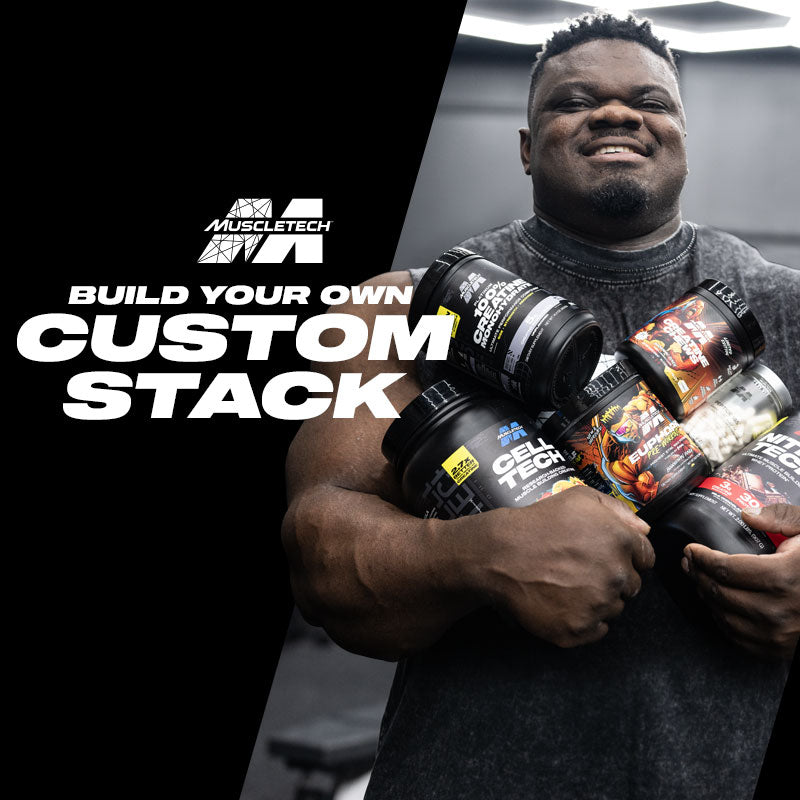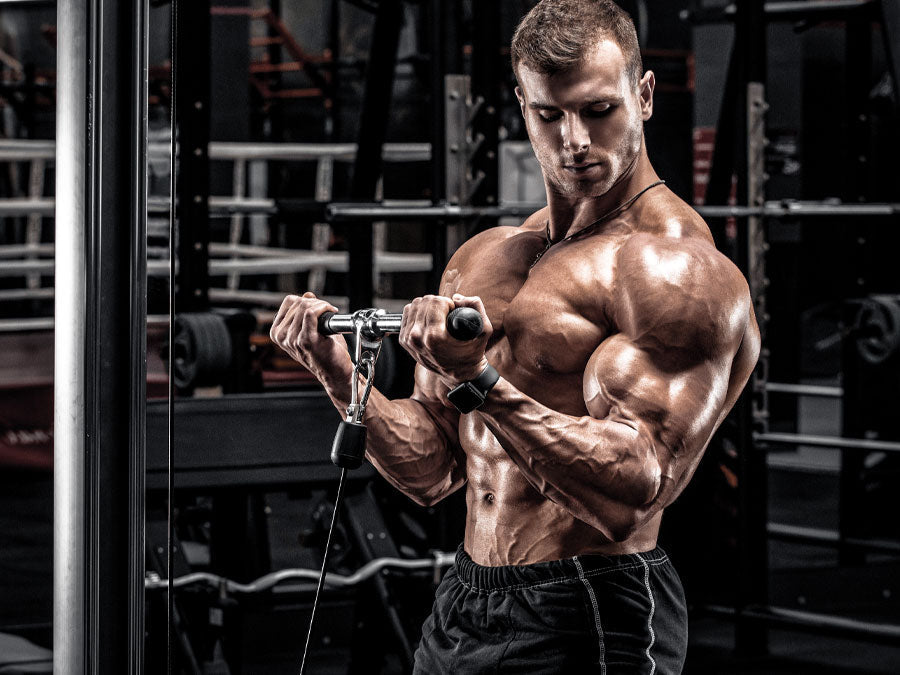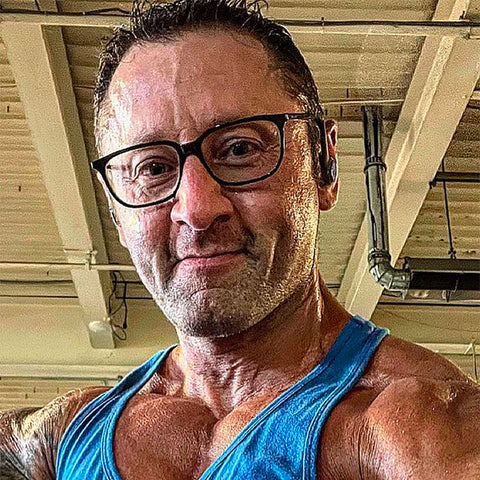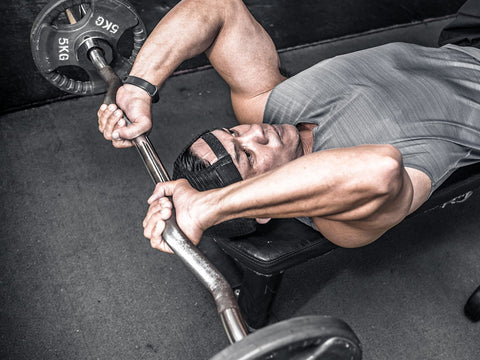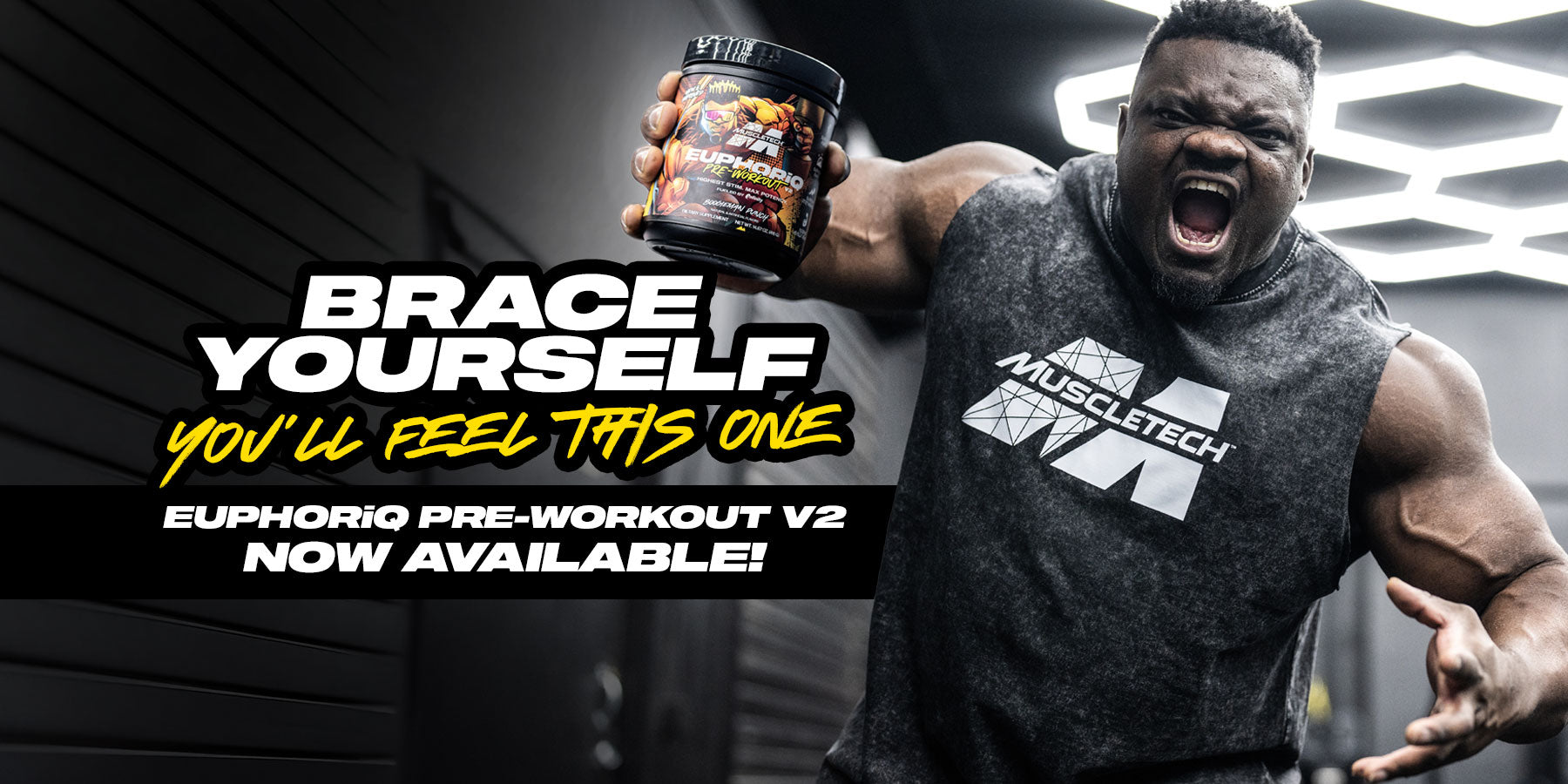By Ron Harris
Certain numbers in bodybuilding instantly signify success and put you into an elite category. When it comes to arms, the measurement to strive for has always been 20 inches. Anything less than that can still be fine, but nobody’s raving about 18- or 19-inch arms.
Genetics certainly come into play, but far more people are capable of building a legitimate 20-inch arm than will ever know. In many cases, if they only did things differently, their arms would grow to their ultimate potential rather than be stalled out one to three inches shy.
This isn’t a sales pitch or a claim that there’s some secret routine that will guarantee any average Joe a pair of 20-inch guns. But just about all of you reading this can get closer to that measurement if you apply the following tips, and some of you will indeed surpass that hallowed 20-inch mark on the tape measure.
Table of content
1. Ditch the Ego Lifting and Train the Muscle
The main reason most people aren’t building bigger arms is universal among lifters around the world: using terrible form and not putting the biceps and triceps under actual tension because other muscle groups are forced to assist. Using more weight than can be handled in decent form is why most people never build the arms they should have. Believe me when I say that nobody cares how much you weight you use for curls or skullcrushers. They see your arms, and those arms are either impressive or not. Lighten up and do it right, and your arms will have a fighting chance to reach that magic 20 inches.

2. Master Your Mind-Muscle Connection
There’s a difference between merely using good form and truly working the muscle, even though both look the same to an observer. You need to feel the biceps and triceps muscles contract and stretch under resistance as you do your reps. An effective way to get better at this is to pantomime the exercises without weight. For example, mimic the motion of a barbell curl, slowly flexing the biceps as you curl upward and consciously stretching them as you lower your arms. (An advanced technique to facilitate this would be to flex the triceps as you lower the resistance.) Once you’re in total control of your muscles and can feel them working throughout every inch of the rep, your results will be greatly magnified.
Also Read: Best Workout Supplements for Men
3. Heavy Chest and Back Work = Bigger Triceps and Biceps
The triceps get plenty of ancillary work when you perform pressing movements for the chest, and the biceps are involved in all types of rows and pull-downs for the back. If you slack on heavy chest and back work, you’re missing out on a substantial amount of residual work—and growth—for your arms. I’ve known men who put most of their training time and energy into heavy, compound movements, with little or no direct arm work. All of them had good-size arms, and some had outright huge arms. The opposite doesn’t seem to bear true. Those who focus mainly on direct arm work with isolation movements and hardly do any heavy chest or back training never get past a certain point of development.
4. Have a Dedicated Arm Day
If your arms haven’t budged the tape measure in many moons, you aren’t doing them any favors by working them after larger torso muscles such as the chest, back, or shoulders. As much as I’m a huge advocate of the Push/Pull/Legs training split, even I concede this point. After working a large torso muscle group, you’re already partially fatigued and simply incapable of applying 100 percent effort to the arms. Devote a dedicated workout day to arms, where that’s all you train. If you want to do a bit of calves or abs afterward, that’s fine. But working your bi’s and tri’s when you’re fresh is the best move if you want them to grow.
5. Hit Them Twice a Week
To prioritize your arms, I strongly suggest that you train them twice a week. By that, I don’t mean you should have two dedicated arm days. For most guys, that would have you overtrained fast. Rather, have one full arm day, then hit the biceps and triceps after another body part. You could do biceps after chest or triceps after delts, for example. You could even adopt this split:
- Push (Chest, shoulders, triceps)
- Pull (Back and biceps)
- Legs
- Arms
- OFF, repeat
I would only do three exercises for three sets each on those days you train larger body parts first (whether you follow P/P/L or a “bro split”), performing straight sets in the 8- to 12-rep range. This is more than enough to keep them full and make sure they aren’t going too long between workouts. Even though I said two dedicated arm workouts a week are probably too much for most men to recover from, working them just once a week may not be enough stimulation either. Do a longer, tougher workout, along with a shorter one that isn’t quite so demanding on your recovery. This strategy has worked well for many.
6. Stretch Those Guns Out
All our skeletal muscles are encased in an extremely tough connective tissue called fascia. Many believe that fascia binds our muscles so tightly that it can impede muscle growth. One way to think about it is how fish will only grow to a certain size in a small tank but can grow larger if given a larger habitat. There’s a good deal of anecdotal evidence that breaking up the fascia can allow additional muscle growth to occur. Deep-tissue massage, a staple among most top-level bodybuilders, is an effective way to achieve this. Another method to disrupt the fascia’s chokehold on your bi’s and tri’s is to stretch them hard while they’re fully pumped.
Also Read: Building Muscle After 60
Followers of John Parrillo and later DC Training swore by this method. Both advocated aggressive, painful stretches held for 30 to 90 seconds, often with weight. Be very careful with this, especially if you’ve never stretched your arms out before or have only done the gentle type of stretching. Also keep in mind that these are static stretches. Under no circumstances would you want to add movement to a weighted stretch, or else you risk a tear.

7. Do Dips and Press for Huge Tri’s
Extension movements for the triceps are essential and work the primary function of the muscle, but one drawback with them is that you’ll never use very heavy loads relative to what is possible with dips and close-grip presses. These compound movements allow you to use some real resistance. A 200-pound guy might be able to do weighted dips with 100 extra pounds or close-grip presses with 315. It’s highly doubtful he would ever use those weights for skullcrushers or cable push-downs.
Also Read: A Complete Guide on Cable Lateral Raise & Alternatives
8. Try Higher Reps
Heavier weights that limit you to 8 to 10 reps certainly have a valuable place in your training arsenal, and plenty of guys have thrived on that rep range throughout their entire training careers. Others found they needed higher reps, as in 12 to 15, or even 15 to 20 at times, to really get that deep burn, ache, and pump in the arms. Most find that a combination of both is most effective in the long term for gains. Unless you’ve at least given higher reps a fair trial for a couple months, you will never know if they could have delivered additional results. Don’t miss out because you have an irrational prejudice against higher reps, as I foolishly did for many years.
9. Take It EZ for Bigger Biceps
Bodybuilders have been told for at least 60 years now that barbell curls are the absolute king of mass-building movements for the biceps. That may be true, but it’s also a fact that the straight bar causes wrist pain in many that can range from mildly annoying to excruciating. It should be obvious that you will never be able to work hard enough on any exercise if you’re limited by pain and discomfort, especially if it’s an issue of structural incompatibility. The angled contours of the cambered bar, better known in the gym world as the EZ-curl bar, typically alleviate wrist pain and allow you to work to your full potential on curls. Don’t keep doing straight bar curls if they kill your wrists!
Also Read: How to Get Bigger Traps?
10. Brace Yourself
If you have large, powerful deltoids, there’s a good chance that they take the stress away from your biceps in any type of standing curl with dumbbells or a barbell. To make sure you work your bi’s rather than your shoulders, do movements where your upper arms are braced and immobile, such as preacher curls, spider curls, machine or cable preacher curls, or concentration curls. Or try doing standing dumbbell or barbell curls with your back firmly up against a wall.
Following this? Well then, you are right on your way to achieving 20 inch biceps ;)
11. Superset for Super Gains
Higher reps are one way to put the muscles under tension longer, and so are supersets. Supersets have been found to be especially effective for arms by bodybuilders dating back to the 1950s. They’re especially productive for those who are accustomed to performing straight sets with 60 to 120 seconds of rest between. For them, the shock of immediately launching into another set forces their muscles to adapt to the new type of stress with growth.
Also Read: When to Take Creatine: Dos and Don’ts
12. Alternate Bi’s and Tri’s
If you completed all your biceps exercises before commencing your triceps work, your triceps would suffer for having to wait while you did all that, and vice versa. You start each workout with a finite amount of energy that becomes depleted as you go along. If you’re just as energetic at the end as you were at the beginning, either you train with zero intensity or you’ve taken a triple dose of pre-workout (not a great idea). A better strategy is to alternate movements for the biceps and triceps. That way, one gets to rest and recover for a few minutes while the antagonistic muscle is worked. An additional bonus is that the resting upper arm muscle is being stretched while the other is contracting, and we’ve already covered the benefits of stretching.
Also Read: Why is Spot Training a Myth?
13. Press on the Smith
The close-grip bench press will certainly add bulk to your triceps. Unfortunately, many of us have a tough time keeping the barbell balanced with anything narrower than a standard bench press grip and find ourselves struggling with that aspect of the lift rather than focusing on working the triceps. That’s why you might be better off doing your close-grip presses on a Smith machine, where balance is taken out of the equation and you can simply build your tri’s.
14. Use a Decline Bench for Better ROM on Skullcrushers
The most basic and effective triceps extension movement you can perform is the one commonly known as skullcrushers. The only problem with the standard version done on a flat bench is that the effective loaded range of motion (ROM) is incomplete, specifically lacking in the stretch component of the rep. Doing the exercise on a decline bench provides a much more complete ROM.
15. Beware of Overtraining
Because the arms are used indirectly in training the chest, back, and shoulders, one must be vigilant of overtraining. More isn’t always better. Just because 20 total sets performed in an hour is effective doesn’t mean that 60 sets in three hours will give you three times more results, or any further results for that matter. A good rule of thumb to follow is that when you lose your pump and can’t get it back, it’s time to call it a day. Hit your biceps and triceps hard and don’t be afraid of some volume, but understand that there’s a point of diminishing returns. If that weren’t the case, 8- or even 12-hour arm sessions would result in the biggest arms possible! Spoiler alert: They won’t.
16. Stop Training Arms—for Just a Little While
If your arms haven’t grown in a very long time, the best course of action might simply be to stop training them for anywhere from a week to a month. I too thought this was utterly ridiculous when I heard it years ago from Evan Centopani. How can you make your arms bigger by not training them? The reason it often works is that the arms are often trained with far more volume than they need or can possibly recover from, especially since they get used so much in other workouts. This also means that you’re still giving your arms some work, even if it isn’t direct. The worst thing that could happen is that your arms lose a fraction of their size, which you would get right back. The best scenario, and one that has been reported by many, is that it “resets” them to make gains once you resume direct work.
Also Read: Does Creatine Make you Gain Weight?
17. Cheat at the Right Times
There’s a time for good form, and there’s a time to loosen it up. The most effective way to introduce “cheating” style reps is within a set, after you’ve already taken it to failure with good form. This allows you to take the muscle further and work it harder, as the other muscle groups are fresh and can assist in the process. Cheating from the first rep takes stress away from the target muscle. So, cheat when it will give the target muscle more work, not less.
18. Go Over Your Head
The triceps have three distinct heads, and the long head that originates underneath your armpit is only worked effectively when your arms are in an overhead position. If you never do any type of overhead extension movement in your triceps training, you’re missing out on substantial development back there. Opt for an overhead dumbbell or barbell extension, seated or standing, or an overhead extension movement using a cable pulley.
Also Read: The Perfect Leg Day Warmup
19. Make Time for Hammer Time
The brachialis is a muscle wedged between the long head of your biceps and the lateral head of your triceps. Though it does get some work from any type of curl, a more direct way to train it is via hammer curls or reverse curls. When fully developed, the brachialis can add a solid inch or more to your upper arm measurement. Don’t tell me you can afford to miss out on that!
20. Believe Your Arms Can and Will Grow!
I saved the best for last, because the mind truly does control the body. You must have faith and believe that your arms can and will grow. If you have doubts, or worse, are convinced that any efforts will be in vain, that negative poison will sabotage your efforts. Either consciously or subconsciously, you will hold back from giving it your all. Why bother? Your arms won’t grow anyway! You’re doomed! Squash that nonsense right now. Your arms aren’t finished growing yet. They’re a work in progress, and it’s up to you to force them to grow through intelligent strategy and pure hard work. Apply these 20 tips, and maybe you can have 20-inch arms busting out of your sleeves!
